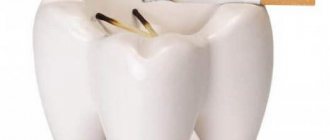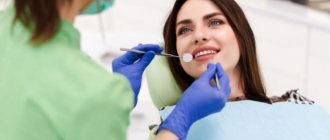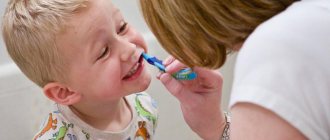- Why is it important to care for baby teeth?
- Which toothpaste to choose for a child
- How to choose a toothbrush for a child
- How to choose an electric brush for a child
- How to reduce the risk of developing caries and not give up sweets
- How to teach a child to brush their teeth
- Tips from a pediatric dentist: video
The age group from 3 to 8 years is characterized by the primary dentition, as well as the beginning of the mixed dentition - the appearance of the first permanent teeth. A child at this age learns to brush his teeth and can use an electric brush independently.
Today we will look at what oral care products you need to have at home for children of this age group. You will learn how to help a child with the habit of brushing their teeth daily, what to use to form healthy permanent teeth, and how to reduce the risk of developing caries without giving up sweets.
Prevention of dental caries in children
During their short existence, baby teeth have a long-term impact and serve for proper biting and chewing, for the formation of vowels, and also preserve space for permanent teeth.
Children from 0-4 years
Teeth and gums hurt as a result of the action of certain bacteria. In the warm and moist oral cavity, they wait for the appearance of sugar or other sugar-containing products, and quickly begin to multiply, create a sticky mass - plaque - and secrete acid and cellular toxins, which harm the teeth and gums.
It is enough to follow simple rules:
- feed your child foods low in sugar;
- offer sweets that are friendly to teeth, i.e. sweet in taste and safe for teeth;
- care for children's teeth and gums from birth.
Treatment of children at the Zuub.rf clinic
Our clinic employs experienced pediatric dentists. Highly qualified doctors successfully treat various diseases in children:
- Caries.
- Pulpitis.
- Gum diseases.
- Restoration after injury.
- Removal of severely affected or decayed teeth.
- Professional oral hygiene.
- Correction of bite in children.
Our clinic has its own diagnostic department. Modern equipment allows for accurate instrumental diagnostics and diagnosis in the early stages of pathology. The results of treatment largely depend on when it was started. Therefore, do not neglect regular preventive examinations. Be sure to visit the dentist during pregnancy and bring your baby to the doctor regularly.
When all the baby teeth are there
How strong are they? Already in the 6th week of pregnancy, baby teeth begin to form. All of their 20 crowns are already fully developed by the time the child is born and take their permanent place in the jaws, even those that appear by the end of the first year of life.
Between 6 and 8 months of life, the first teeth appear. Alternately, they cut through the swollen gums. Sometimes this is a painful process, and the child worries and cries more often. In some cases, teething toys help, but how to deal with mom's loving concern? After all, in fact, there is no such disease as “teething.” Research shows that rising temperatures and other ailments during this period of life are a coincidence.
By the time all 20 baby teeth have erupted—which takes about 2 years—each one needs care.
Dental prevention. ATTENTION: SUGAR!
Sugar is found in breast milk and therefore cannot be excluded from the diet of infants. It is also present in healthy fruit juices and is the main cause of tooth decay. And in order to prevent it from appearing on children’s wonderful teeth, you, dear parents, must help them from the first day.
For children in the first year of life, special baby brushes are made of very soft bristles or completely made of rubber. Systematically, after each meal, the gums and baby teeth should be cleaned on all sides, for example, using a cosmetic spatula wrapped in dry cotton wool. Then you can start using the first soft toothbrushes as early as possible. You need to practice everything that brushes your teeth with fun and humor: open your mouth, show your teeth, brush them, rinse your mouth. Try to effectively use children's curiosity and desire to imitate adults - and brushing your teeth will become real fun associated with pleasant emotions.
At 2 years old, your child already has his own brush with a small, soft head and a small, thick handle. Cleaning is done “from red to white”, i.e. sweeping movements from the gums to the teeth, chewing, internal and external surfaces of the teeth. Proper and good cleaning is not such a simple matter. Be sure to monitor the child and repeat the procedure if necessary.
Which toothpaste to choose for a child
The choice of toothpastes for children 3–8 years old is slightly wider than for toddlers - the child has already learned to spit out the toothpaste, so it may contain fluoride.
When choosing a toothpaste with fluoride, look at the safe concentration of this component - this is 500-900 ppm for children from 3 to 8 years old.
In addition to paste, you can use gels that strengthen the enamel. For example, Tooth Mousse - it helps to get rid of increased sensitivity and prevent the development of caries. There is no sugar in it, and the main components of the gel are calcium and phosphates, which are necessary for dental health. Remineralizing gel can be applied after brushing directly to the teeth or in special trays.
What should not be in baby toothpaste?
The fact that a child has already learned not to swallow toothpaste does not mean that he will not do this if the paste is especially tasty. For such cases, manufacturers have excluded harmful substances from the composition and found substitutes for them.
Children's toothpaste should not contain SLS and parabens. If the paste foams, it means it contains SLS, and it is better to discard it.
In addition, for proper care it is important that the baby toothpaste contains a minimum amount of abrasive substances. Soft abrasives are necessary for effectively cleaning teeth from plaque in adulthood, but there should be little of them in the composition of children's toothpaste. On the packaging, the degree of abrasiveness is indicated by the abbreviation RDA and for children ranges from 0 to 50.
What substances are useful in baby toothpastes?
Pay attention to the composition when choosing a new toothpaste for your child. You already know what should not be in the composition. Useful substances include fluorine and hydroxyapatite (or nanohydroxyapatite).
- Fluoride is an important substance for teeth, so toothpaste should contain a small amount of fluoride, which is usually indicated on the package. For children under 4 years old - 200 ppm, from 4 to 8 years old - 500 ppm.
- Hydroxyapatite is a modern alternative to fluorine. Synthetic hydroxyapatite is identical to the natural one that makes up enamel. It easily integrates into its crystal lattice and strengthens it, sealing microcracks and reducing sensitivity. In addition, hydroxyapatite eliminates caries at the white spot stage.
- Flavoring additives. This is not the most important and useful component - its choice depends on the preferences of the child himself. But it is important to know that flavors in children's toothpaste do not have to be of natural origin. Now special synthetic analogues have been developed that are completely safe if swallowed.
Toothpaste Dentissimo Junior Apple (from 6 years old)
Toothpaste ROCS (ROCS) Kids Berry Fantasy (from 4 to 7 years)
Toothpaste Brush-Baby Multifruit (from 3 to 6 years)
Biorepair Kids toothpaste with strawberry flavor (from 0 to 6 years)
Prevention of dental caries
Children 4-6 years old
Baby teeth are often underestimated, but they play a very important role in the future development of a child.
First, the child uses his baby teeth to bite and chew. When they are positioned correctly, food is properly ground and prepared for digestion.
Secondly, baby teeth make it possible for a child to speak correctly. A lisp, for example, is a consequence of too early loss of baby teeth.
Third, baby teeth hold space in the jaw for permanent teeth. The child's molars should remain until they are 11-12 years old.
Baby teeth cannot resist caries. Therefore, you need to remember that after eating and drinking, especially sticky sweets, food remains remain between the teeth, get stuck in the recesses of the molars, along the edges of the gums. The oral cavity is home to millions of bacteria that convert sugars and carbohydrates into harsh acids, which in turn attack and dissolve tooth enamel. To protect yourself from caries, you need to remember:
How to choose an electric brush for a child
From the age of 3 you can start using an electric brush. The advantage is that in children's lines you can find great opportunities for interactivity.
Some brands produce electric brushes with the ability to control brushing time via an app. The mobile application synchronizes with the brush and uses animated prompts to teach your child how to brush their teeth correctly. This helps maintain interest in the process.
For children aged 3 to 6–7 years, an electric brush with the softest bristles is suitable. It can be alternated with a regular brush. But remember: the use of an electric brush by a preschool child needs to be supervised.
Prevention of dental treatment - brush correctly
about rinsing your mouth or chewing sugar-free gum after every meal and sweets.
Children 6-12 years old
When new teeth are on the way
Something happens in your mouth, or more precisely in the upper and lower jaws: one baby tooth after another says goodbye to you, and new permanent teeth appear in their place. This process will last up to 12 years! Exception: at the age of 6, the permanent one is visible behind the last milk tooth, although none falls out. This is a six-year-old molar. It is important for the further development of the dentition. Therefore, it needs special care and must be coated with a special sealing compound. The reason: the enamel of the “new” teeth is not yet completely hard at the time of eruption and is therefore at risk of caries. The same applies to the remaining molars.
Why do you need to protect the health of baby teeth?
Two main reasons:
- Because a child who has not learned to take care of his teeth in childhood will continue to be inattentive to dental health in the future.
Moreover: when faced with pain, a child may begin to fear doctors and avoid visiting them. Since almost all people are susceptible to tooth decay (the disease affects up to 93% of the world's population), failure to receive regular dental care will result in tooth loss in the future.
Healthy and sick tooth: picture for children
- Because baby teeth need to be preserved until their natural replacement.
Losing baby teeth too early is a high risk of permanent malocclusion in the future. The roots of baby teeth, although much shorter than those of permanent teeth, perform an important role: they support the jaw tissue, transfer the load to it during chewing and contribute to its normal growth. If multiple teeth are lost, jaw development may be delayed. In this case, when the permanent teeth begin to emerge, there may not be enough space for them, so they will not grow along an even arch line, but where they can, which will lead to crowding. In addition, if the development of the lower jaw lags behind the upper jaw, a distal bite may occur, in which the lower teeth are pushed back relative to the upper teeth. This anomaly is treatable, but preventive measures are always better than urgent ones.
Do baby teeth need to be treated? Yes, definitely - to avoid their removal. For example, caries develops gradually: from stage 1 (white spot) to stage 2–3, when the tooth is already partially destroyed. But even at this stage, the tooth can be saved if treated in time.
If this is not done, nerve inflammation may begin. Pulpitis of a baby tooth is the last, 4th stage, accompanied by pain ranging from aching to acute. Unfortunately, after this it is quite difficult to save the tooth.
The most important factor influencing dental health is not heredity, but timely and constant care.
Getting used to cleaning
You need to start brushing from the moment the first tooth erupts. Until one year of age, toothpaste is not necessary - a soft silicone brush is sufficient. A brush in the shape of a teether is considered convenient - the child can hold it himself, while simultaneously cleaning the teeth and relieving itching from teething.
Silicone teething brush
After 1 year, you can use a soft bristle brush and toothpaste with the required age marking. Such pastes do not contain fluoride; you do not need to spit them out (use a small amount).
For children, there are also electric toothbrushes that have soft bristles and weak vibrations.
Children's electric toothbrush
It is optimal to brush your teeth twice a day, especially important before bed, after the last meal.
Proper nutrition
It is impossible to completely deprive a child of sweets, but the basis of nutrition should not be treats, but valuable foods: meat, fish, vegetables, fruits, cottage cheese, and so on.
The problem with sweets is that they create an acidic environment in the mouth, in which the enamel quickly thins out and becomes brittle. Therefore, the consumption of sugar, chocolate and other treats should be limited, and after them it is advisable to brush your teeth.
Sweets in large quantities have been proven to harm teeth
Scheduled appointments
If adults usually need a visit once a year, then children need to visit the dentist more often - once every 6 months. The enamel of children's teeth is thin, caries develops quickly. Therefore, it is important to notice it at an early stage so that the treatment is short-lived, does not bring discomfort to the child and does not create a negative impression on him. In addition, the smaller the filling, the greater the chance that the tooth will live with it until it falls out.
Healthy, strong baby teeth are the basis for a future permanent dentition. In addition, having gotten used to visiting the dentist since childhood and knowing that a planned appointment is not scary, the child will treat treatment more responsibly in the future.
Stored hermetically
Your teeth can cause you a lot of problems, because they have so many vulnerable places: the cavities of the chewing surfaces of the molars, the interdental spaces, the necks of the teeth and the edges of the gums. This is where the sticky coating forms. The bacteria in it greet everything sweet with great joy. Then they multiply millions of times. Their waste products - acids - cause caries.
Filling the chewing surfaces of teeth with special compounds (sealing) means their protection and safety and is performed by a dentist. Despite this, all teeth should be thoroughly brushed and floss should be used between teeth. Ask your dentist to tell you more about sealants and flossing.
Almost half of children have an incorrect bite. Make sure that your child does not encounter such a problem. A significant role in the prevention of dental caries is played by the prevention and elimination of developed dentoalveolar deformities. Orthodontic treatment aimed at normalizing the bite, eliminating crowding of teeth, and reducing the likelihood of caries.
13-18 years old
Communication between people is becoming easier: for on-line surfing on the Internet, just a mouse click is enough... Only one thing complicates the communication process. Each serving of fast food with ketchup, ice cream, cola and other similar daily snacks throws our most important communicative organ - the mouth - out of ecological balance. When there is not enough systematic oral care, caries naturally occurs and gums hurt.
Prevention of dental diseases
Two phases characterize caries :
Phase I – “demineralization” of teeth. Dissolution of enamel crystals under the tooth surface. Outwardly, everything looks OK, only white, chalk-like spots signal danger. At the first stage, everything is curable, but with the condition of intensive dental care. If sugar continues to be present, your teeth will have a particularly hard time.
Phase II - the appearance of a hole in the tooth - caries. But this is already incurable!
Fluorine is nature itself
Fluoride is not only found in our saliva, it is a natural component of our environment and a mineral that can be called an absolute “power” for teeth and bones. Fluoride increases the resistance of enamel to acids.
Prevention of children's teeth - care
Our body’s “laboratory” produces fluoride in saliva, but it is no longer enough to effectively protect our teeth. Too many Big Macs, Snickers, and chewy candies have made it difficult for saliva to perform this function. She needs help:
- brush your teeth twice a day with a toothpaste containing fluoride;
- once a week, carry out intensive fluoridation with products containing fluoride (gels, for example);
- coat your teeth with fluoride varnish monthly;
- eat fluoridated salt.
If plaque is not regularly removed from teeth, it turns into tartar, visible on the surface of the teeth. Tartar increases in size and imperceptibly “grows” under the gums towards the root of the tooth. A thin layer of tartar is stained by exposure to nicotine, tea or red wine.
Fluoride varnish coating is professional protection against caries. Professional cleaning means removing tartar, incl. deposits invisible to the eye, which should be carried out by the dentist at least twice a year.
But that is not all. Only polishing finally rids the roots of residual layers of tartar.
Moreover. Polishing makes it more difficult for stone to form. Polishing all surfaces of the teeth after removing plaque using brushes, polishing heads, superflosses, strips, brushes and pastes allows you to make your teeth very smooth. Only with the help of professional cleaning can gum disease be cured. And the degree of its success can be checked with the tip of your tongue!










